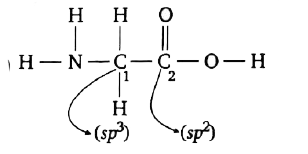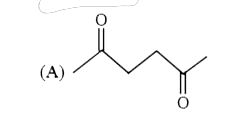Explore topic-wise InterviewSolutions in .
This section includes InterviewSolutions, each offering curated multiple-choice questions to sharpen your knowledge and support exam preparation. Choose a topic below to get started.
| 13601. |
What is the relationship between (I) & (II) |
|
Answer» Enantiomer |
|
| 13602. |
Which of the following oxide is least stable? |
|
Answer» `CO_2` |
|
| 13603. |
Write the products formed in the reaction of nitric acid with dilute and concentrated with magnesium. |
|
Answer» Solution :(i) Magnesium with conc. `HNO_(3)`: `4Mg+10 HNO_(3)rarr 4Mg(NO_(3))_(2)+NH_(4)NO_(3)+3H_(2)O` Magnesium reacts with concentrated nitric acid to GIVES both magnesium NITRATE and ammonium nitrate. (ii) Magnesium with dil. `HNO_(3):` Magnesium reacts with dilute nitric acid to gives both magnesium nitrate and nitrous OXIDE. `4Mg+10HNO_(3)rarr 4Mg(NO_(3))_(2)+N_(2)O+5H_(2)O` |
|
| 13604. |
Two elements A (at. mass 16) and B (at. mass 14) combine to form compounds X, Y and Z. The ratio of different masses of B which combine with a fixed mass of A in X, Y and Z is 1:3:5. If 32 parts by mass of A combine with 84 parts by mass of B in X, then in Z, 16 parts by mass of A will combine with |
|
Answer» 14 PARTS by mass of B |
|
| 13605. |
Which of the folowing is not a state function ? |
|
Answer» Heat |
|
| 13606. |
What is a double salt ? Give an example. |
|
Answer» Solution :Double salts are those compounds which LOSE their identities in solutions and BREAK down into SIMPLE ions and exist in crystalline state. Example: Double salts like Potash ALUM `(K_2SO_4. AI_2 (SO_4)_3.2H_2O)` in aq. solution break down into `K^+, AI^3+, SO_4`. ions where they lose their identity. `K_2SO_4.AI_2(SO_4)_3. 24H_2OrarrK^(+)+2AI^(3+)+4SO_4^(=)+24H_2O` |
|
| 13607. |
Which relation is true, if molecular weight of solute is x and its weight is y ? |
|
Answer» `X=((y)/(V))(RT)/(pi)` |
|
| 13608. |
Which of the following is not a state function |
|
Answer» Internal energy |
|
| 13609. |
The sequence of ionic mobilty in the aqueous solution is |
|
Answer» `K^(+) gt NA^(+) gt Rb^(+) gt Cs^(+)` `Na^(+) lt K^(+) lt Rb^(+) lt Cs^(+)` The sizes of the hydrated ions will be in the order: `Cs^(+) lt Rb^(+) lt K^(+) lt Na^(+) ` Hence, their ionic mobilities will be in the order: `Cs^(2+) gt Rb^(+) gt K^(+) gt Na^(+)` |
|
| 13610. |
Which of the following does not represent functional isomers of each other ? |
|
Answer» `CH_(3)CH_(2)NO_(2) " and " CH_(3)CH_(2) O - N` |
|
| 13611. |
The solubility product of a sparingly soluble salt AB at room temperature is 1.21 xx 10^(-6). Its molar solubility is |
|
Answer» `1.21 xx 10^(-6)` `S = SQRT(K_(sp)) = sqrt(1.2 xx 10^(-6)) = 1.1 xx 10^(-3) M`. |
|
| 13612. |
The sulphur molecule (S_8)possesses: |
|
Answer» CUBICAL structure |
|
| 13613. |
Which of the following is largest |
|
Answer» `Cl^(-)` |
|
| 13614. |
The statements regarding oxyacids of phosphorous are i) HPO_(3) molecule is monobasic acid ii) H_(4)P_(2)O_(6) molecule has P - P bond iii) H_(4)P_(2)O_(7) molecule has P - O - P linkage The correct combination is |
|
Answer» All are correct |
|
| 13615. |
What are the hybridisation of the carbon atoms labeled C_(1)and C_(2), respectively in glycine ? |
|
Answer» `{:(C_(1),C_(2)),(SP^(2),sp^(2)):}` 
|
|
| 13616. |
Which of the following do not exhibit resonance. |
|
Answer» `CO_(3)^(-2)`  No resonance (all SINGLE bond) |
|
| 13617. |
Which drug is used for prevention of impregnation ? |
|
Answer» Mestranol |
|
| 13618. |
Which one of the following statement is true for transition elements |
|
Answer» They exhibit diamagnetism |
|
| 13619. |
What ratio of Pb^(2+) to Sn^(2+) concentration is needed to reverse the following cell reaction ? Sn(s)+Pb^(2+) (aq.) rarr Sn^(2+) (aq.)+Pb(s) E_(Sn^(2+)//Sn)^(@)=-0.136 volt and E_(Pb^(2+)//Pb)^(@)=-0.126 volt |
|
Answer» |
|
| 13620. |
Which one of following is more reactive than the rest towards a Lucas reagent ? |
|
Answer» 1-butanol `(CH_3)_3C-OH+H^(+) to (CH_3)_3C-O^(+)H_2 to (CH_3)_3C^(+) + H_2O` `(CH_3)_3C^(+) overset(Cl^-)to (CH_3)_3C-Cl` |
|
| 13621. |
The value of Planck's constant is 6.62618 xx 10^(-34) Js . The number of significant figures in it is : |
|
Answer» six |
|
| 13622. |
Wurtz reaction of methyl iodidie yields an organic compound X. which one of the following reactions also yields X |
|
Answer» `C_(2)H_(5)Cl+Mgoverset("dry ether")to` `2CH_(3)I+2Na underset(ether)overset(dry)toC_(2)H_(6)+2NaI` Similarly `C_(2)H_(5)Cl` reduced by `LiAlH_(4)` to GIVE ethane `C_(2)H_(5)Cl+2H overset(LiAlH_(4))toC_(2)H_(6)+HCl` |
|
| 13623. |
The specific conductivity of an aqueous solution of a weak monoprotic acid is 0.00033 ohm^(-1) cm^(-1) at a concentration 0.02 M. If at this concentration the degree of dissociation is 0.043, then calculate the value of lambda_(0) ("in"ohm^(-1)cm^(2)//eqt): |
|
Answer» 483 so `lambda_oo=(33xx50xx10^(-2))/0.043 =383.72 ~~384` |
|
| 13624. |
Which halide has the highest melting point |
|
Answer» NaCl |
|
| 13625. |
What are called to drugs which are used to prevent parasite ? |
|
Answer» Antibacterial |
|
| 13626. |
Which one of the following can be classified as Bronsted base? |
|
Answer» `CH_(3)COOH` |
|
| 13627. |
Which of the following amines form N-nitroso derivative when treated with NaNO_(2) and HCl |
|
Answer» `CH_(3)NH_(2)` |
|
| 13628. |
Which statement of the following is incorrect . |
|
Answer» Molecularity of a reaction is always a whole number |
|
| 13629. |
There is no test (Direct) for the detection of following in an organic compound: |
|
Answer» CI |
|
| 13630. |
Unpaired electron in CH_3 occupies: |
|
Answer» sp-HYBRID ORBITAL |
|
| 13631. |
Under what reaction conditions (acidic/basic), the coupling reaction of aryldiazonium chloride with aniline is carried out ? |
|
Answer» |
|
| 13632. |
Which of the following satements is correct ? |
|
Answer» All AMINO acids are OPTICALLY active |
|
| 13633. |
Which is not true about borax? |
|
Answer» It is a useful primary standard for titrating against acids |
|
| 13634. |
Write the reactions showing the presence of following in the open structure of glucose : (i) A carbonyl group(ii) Straight chain with six carbon atoms |
|
Answer» Solution :(a) A carbonyl group `{:(CHO,,CH=N-OH),(|,,"|"),((CHOH)_(4),overset(NH_(2) OH)to,(CHOH)_(4) ),(|,,"|"),(CH_(2) OH,,underset("GLUCOSE oxime")(CH_2 OH)):}` (b) Straight chain with six CARBON atoms `{:(CHO),("|"),((CHOH)_(4)),("|"),(CH_2 OH),():}overset(HI,Delta) (to) CH_3 -CH_2 -underset("n-Hexane") ( CH_2 - CH_2) - CH_3` |
|
| 13635. |
Which of the following taking place in the Blast fuenace is endothermic ? |
|
Answer» `CaCO_(3)to CaO + CO_(2)` |
|
| 13636. |
Which of the following would undergo aldol condensation : |
|
Answer» `C Cl_3CHO` |
|
| 13637. |
Which will give a white precipitate with AgN03 in aqueous solution |
|
Answer» `[Co(NH_(3))_(5)Cl](NO_(2))_(2)` |
|
| 13638. |
Which of the following solution has higheset resistance ? |
|
Answer» 1 N NaCl |
|
| 13639. |
(x)underset(H_(2)O) overset(OH^(-))(rarr)beta -hydroxy ketone (x) can't be |
|
Answer»
|
|
| 13640. |
Which of the following may have hexagonal or trigonal crystals : |
| Answer» Answer :B | |
| 13641. |
Which of the following has electronic configuration in violation to Aufbau principle? |
|
Answer» SILVER (Z=47) |
|
| 13642. |
What are lyophilic and lyophobic sols ? Compare th two in terms of stability and reversibility. |
| Answer» | |
| 13643. |
Which structure of polymer is correct ? |
|
Answer»
|
|
| 13644. |
Write the IUPAC names of the following coordination compounds(a) [Pt(NH_(3))_(2)CH(NO_(2))((b) K_(3)Cr(C_(2)O_(3))] C) [CoCl_(2)(en)_( 2)]CI(d). [CO(NH_(3))_(5)(CO_(3)]CI (e) Hg[Co(SCN)_(4)] |
|
Answer» Solution : diamminechloridonitroplatinum(II) (b) potassium trioxalatochromate(III) (c) dichlororido bis(ETHANE - 1,2-diamine) cobalt(III) CHLORIDE (d) pentaamminecarbonatocobalt(III) chloride (e) mercury TETRATHIOCYANATOCOBALTATE(II) |
|
| 13645. |
What is meant by 'shape-selective catalysis' of reactions ? |
| Answer» Solution :The CATALYTIC reaction which depends upon the PORE STRUCTURE of the catalyst and the size of the reactant and product molecules is CALLED shape selective CATALYSIS. | |
| 13646. |
Which of the following is/are correct concentration term (s) for 11.2 volume H_(2)O_(2) solution ? (density of solution = 1.034 gm//ml ) |
|
Answer» Molarity = 1 M = 1 1 MOLE in 1 litre solution 1 mole in 1034 GM solution(DENSITY of solution `= 1.034` gm/ml ) Mass of solvent `= 1034 - 34 = 1000 gm` Molality (m) `= ("1 mole")/(1 kg) = 1m` (C ) `% w//v = ("weight of solute")/("Volume of solution") xx 100 = (34)/(1000) xx 100 = 3.4%` (D) `11.2 = 11.2 m` `m = 1 rArr 1 "mole" H_(2)O_(2)` in 1000 mL solution `rArr 34 gm H_(2)O` in 103 gm solution `% w//w = (34)/(1034) xx 100 = 32.8 %` |
|
| 13647. |
Which of the following compounds show optical isomerism ? (a) Cis - [Co(NH_(3))_(4)Cl_(2)]^(+) (b) trans - [Co(e n)_(2) Cl_(2)]^(+) (c ) cis - [Co (e n)_(2)Cl_(2)]^(+) (d) [Co (e n)_(3)]^(3+) |
|
Answer» a & b optically INACTIVE, due to PRESENCE of P.O.S. |
|
| 13648. |
The vapour pressure of two miscible liquids A and B are 300 and 500 mmHg respectively. In a flask 10 moles of A are mixed with 12 moles of B. However, as soon as B is added, A starts polymerising into a completely insoluble solid. The polymerisation follows first order kinetics. After 100 minutes, 0.525 mole of a solute is dissolved which arrests the polymerisation completely. The final vapour pressure of the solution is 400mmHg. Estimate the rate constant of the polymerisation reaction. Assume negligible volume change on mixing and polymerisation, and ideal behaviour for the final solution. |
|
Answer» Solution :10 "mole" `nA(l)overset(B(l)(12"mole"))underset("POLYMERISATION")(to)An(s)` After 100 MIN : x moles (say) Rate LAW : Rate `=-(1)/(n) (d[A])/(dt)=k.[A]` or `-(1)/(n)(dx)/(dt)=k.(x)` On integration : `nk.=k=(2.303)/(t)log.(a)/(x)`............(1) [In this PROBLEM n is not given. As n i.e., no. of molecules of a polumerising to give one molecule is a constant for this reaction and so the multiplication of n with the rate constant k. gives another constant k, which may also be CALLED rate constant, though not according to its definition] Let us now calculate x to get the value of k from Equation (1) . When `0.525` mole of a solute is added , polymerisation stops and x moles of A remain. Just before the addition of the solute moles of solvent `A=x` moles of solvent `B=12` `:.` vapour pressure of the mixture of solvents `=x_(A)p_(A)^(0)+x_(B)p_(B)^(0)` `p^(0)=(x)/(x+12)xx300+(12)/(x+12)xx500`.............(2) Vapour pressure of the solution `p=400`............(3) (after the addition of `0.525` mole of solute) Applying Raoult.s law `(p^(0)-p)/(p^(0))=` mole fraction of the solute `=(0.525)/(0.525+(x+12))` ...........(4) Solving equations (2), (3) and (4) we get `x=2.84` Substituting `x=2.84`, `t=100m` and `a=10` in Equation (1) `k=(2.303)/(100)log.(10)/(2.84)=1.2xx10^(-2)min^(-1)` |
|
| 13649. |
The standard reduction potential for Cu^(2+)//Cu is +0.34V. Calculate the reduction potential at pH=14 for the above couple. K_(SP) of Cu(OH)_(2) is 1.0xx10^(-19) |
|
Answer» 2.2 V Hence, `[OH^-]=1M [H^+][OH^-]=10^(-4)` `CU(OH)_2 to Cu^(2+) + 2OH^-` `K_"SP"=[Cu^(2+)][OH^-]^2` For the REACTION, `Cu^(2+) + 2e^(-) to Cu , n=2` `E_"cell"=E_"cell"^@-0.0591/n"log"1/([Cu^(2+)])` `E_"cell"=0.34-0.0591/2"log"1/(1xx10^(-19))`=-0.22 V |
|
| 13650. |
Which of the following oxidation state is common for all lanthanoids ? |
| Answer» Answer :B | |






